2. Huawei Technologies Co., Ltd., Shenzhen 518129, China
I. INTRODUCTION
CYBER-PHYSICAL systems (CPSs) are integrations of abstract computations,networking and physical plants,in which sensors,actuators and embedded devices are networked to sense,monitor and control the physical world[1, 2, 3, 4, 5, 6]. With the development of wireless communication,networking and embedded system technologies,recent years have witnessed the emergence of CPSs in a broad range of applications,e.g.,industry automation,smart grid,remote healthcare,smart transportation and so forth[7].
The typical architecture of a CPS,as shown in Fig. 1,includes physical layer,cyber layer and networking layer[8, 9, 10]. At the physical layer,sensors and actuators are responsible for information collection and controlling the physical world,respectively. At the cyber layer,upon receipt of the inputs,the real-time decision making system executes the abstract computations to analyze the collected data and then relays the decision to the actuators in the physical world by a sequence of control orders. Networking layer is responsible for the reliable and real-time interconnection of physical layer and cyber layer[11, 12, 13, 14]. As medium access control (MAC) arbitrates the access to shared precious spectrum resources,the reliable and real-time MAC for CPS networks remains an issue that deserves extensive research efforts.
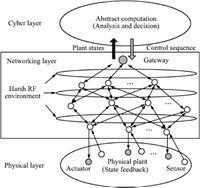 | Download: |
| Fig. 1 A typical CPS architecture. | |
Deterministic MAC protocols such as time division multiple access (TDMA)[15, 16, 17, 18] and polling MAC protocols[19, 20, 21, 22, 23, 24, 25] are widely adopted in wireless networks for industrial process monitoring because they could guarantee a deterministic medium access and data transmission. However,existing deterministic MAC protocols[15, 16, 17, 18, 19, 20, 21, 22, 23, 24, 25] cannot meet the high communication requirements by CPS applications (closed-loop control) due to the inefficient utilization of precious bandwidth. For example,link-level retransmission is an extensively used method to improve the reliability of MAC protocols. When link-level retransmission is adopted in TDMA scheduling,lots of retransmission slots need to be allocated for high reliability,however they are utilized with a low probability. While in a polling MAC protocol,most polling requests are wasted when only a small fraction of nodes in the polling list have packets to transmit. As the node density in CPS applications is normally large (e.g.,node densities of robot end effector,rotary equipment and proximity switches in typical field applications are 2(m3),10(m3) and 120(cell),respectively[25]),the heavy communication overhead of existing deterministic MAC protocols results in a significant performance degradation.
Aiming to meet the high communication requirements by CPS applications,we need to design a cost-effective MAC protocol which yields high efficiency of bandwidth utilization and consequently ensures reliable and real-time data transmission. Motivated by recent contributions[25, 26, 27, 28] leveraging orthogonal frequency-division multiplexing (OFDM) modulation to resolve channel contention of IEEE 802.11 MAC in the frequency domain,this paper proposes a novel priority-aware frequency domain polling MAC (PFDP-MAC) protocol for OFDMA-based CPS networks. PFDP-MAC exploits a priority-aware frequency domain polling method that allows the access point (AP) to simultaneously collect both the responses and transmission priorities from stations. Based on the polling result,PFDP-MAC optimizes the OFDMA resource allocation for reliable communication. In order to address the non-polynomial (NP)-complete nature of the OFDMA resource allocation problem,we derive two heuristic rules and with them propose a lightweight heuristic algorithm to solve the NP-complete problem. The contributions of this work are summarized as follows:
1) We devise a cost effective MAC protocol (PFDP-MAC) which moves the priority-aware polling procedure from time domain into frequency domain. The polling overhead is thus significantly reduced.
2) We formulate a novel OFDMA resource allocation problem aiming to minimize the network timeout probability and propose a heuristic algorithm to solve it. To the best of our knowledge,this work is the first paper to study the OFDMA resource allocation for the reliable transmission in CPS networks.
3) We demonstrate the performance advantage of PFDP-MAC over the IEEE 802.16 MAC through simulations. Additionally,the reliability requirement of typical CPS applications-factory automation is shown to be met by PFDP-MAC.
The rest of this paper is organized as follows. Section II reviews related work. Section III presents the protocol architecture of the proposed PFDP-MAC and illustrates the priority-aware frequency domain polling process particularly. In Section IV,the OFDMA resource allocation problem aiming to improve the reliability of PFDP-MAC is formulated,and solved by a heuristic algorithm. In Section V,simulations validate the efficiency of PFDP-MAC. Section VI concludes this paper and points out future directions.
II. RELATED WORK
In the context of TDMA MAC protocols for CPS networks (including wireless sensor networks and industrial wireless networks),Zheng et al.[15] study the question of how many slots to allocate for retransmissions from a reliability-lifetime tradeoff perspective in wireless sensor networks. Gamba et al.[16] consider different retransmission strategies for centralized wireless industrial networks subjected to external interference,by experimentally showing that the straightforward bounded immediate retransmission scheme can be improved in different ways. Zhang et al.[17] propose an adaptive and reliable transmission scheduling algorithm for wireless sensor networks based on low-cost estimation of channel states. Willig and Uhlemann[18] investigate how to schedule the TDMA slots for retransmissions while taking advantage of the relay nodes so that the average number of packets missing their deadlines is minimized. The spirit of TDMA MAC protocols for highly reliable transmission is to reserve sufficient communication resources (e.g.,time slots and relays) to cope with the uncertainty of wireless channel. However,as shown in [25],resources for retransmission are normally utilized with a rather low probability,which reflects the inefficiency of existing TDMA MAC protocols for industrial wireless networks.
Polling MAC protocols are widely adopted in wired industrial communication standards,such as Ethernet powerlink,ProfiBus and WorldFIP. Willig[19] proposes a set of polling-based MAC protocols for wireless implementation of ProfiBus and results indicate that polling MAC protocols are good substitutes for wireless ProfiBus. Seno et al.[20] propose a wireless extension of Ethernet powerlink based on IEEE 802.11 WLAN and its polling time is theoretically analyzed and experimentally evaluated in [21]. Son et al.[22] devise an effective and simple polling scheme for IEEE 802.11e networks (OFDM physical layer) to reduce the number of polling times for station with no packets to transmit by using traffic characteristics and the number of successive polling times for a station with packets to transmit. Perez et al.[23] present an efficient multipolling scheme that improves the IEEE 802.11g (OFDM physical layer) MAC protocol efficiency and does not suffer from the hidden terminal problem or inefficient channel usage problems. Lam et al.[24] present a survey of different polling-based protocols for supporting voice over various types of IEEE 802.11 WLANs. In particular,three key issues are discussed: managing a polling list,determining the polling sequence,and reducing polling overhead. %Through the use of these values,the period of polling for a station can be adaptively changed. Therefore,this method improves the inefficiency of the polling for stations with no packets to transmit. The inefficiency of existing polling schemes lies in the sequential polling of all the stations in the polling list (non-active stations may be removed after a predefined time period) regardless of their actual demands. In CPS networks,the polling cycle should be sufficiently short to precisely trace the control parameters,which effectively limits the number of stations (or network scale) supported by existing polling MAC protocols.
Aiming to improve the efficiency of IEEE 802.11 MAC,recent works[25, 26, 27, 28] take advantage of OFDM modulation to reduce the communication overhead of coordinating multiple stations. Sen et al.[26] reduce the backoff overhead by counting contention using subcarriers. Feng et al.[27] extend the use of OFDM subcarriers to reduce all three overheads (including distributed inter-frame spacing (DIFS),random backoff and acknowledgement (ACK)) in IEEE 802.11 DCF. Wang et al.[28] move the cooperative sensing and multi-channel contention in cognitive ad hoc networks from time domain to frequency domain by OFDM modulation,which significantly reduces the control overhead caused by cooperation and contention. Xiao et al.[25] combines frequency domain technologies with the polling-based 802.11 MAC protocol (FDP-MAC) for industrial wireless networks in which multiple stations are polled concurrently and a dynamic TDMA scheduling method along with a downlink acknowledgement aggregation method are further proposed to improve the physical layer efficiency. However,there are two main limitations of [25]. One is that packet priorities of stations cannot be collected by the AP with the frequency domain polling method. The other is the poor bandwidth efficiency of dynamic TDMA scheduling,especially when the network scales.
Similar to [25],the PFDP-MAC is also a frequency domain polling MAC protocol. However,there are two fundamental differences between PFDP and FDP. First, FDP uses subcarriers to identify stations while PFDP uses subcarriers to identify the priorities of stations. In doing so,priority-aware frequency domain polling is proposed for the first time in this paper. Second, the FDP-MAC[25] is designed for OFDM networks, while PFDP-MAC is designed for OFDMA networks. OFDMA is a multi-user version of OFDM. Specifically,multiple access is achieved in OFDMA by assigning subsets of subcarriers to individual users. This allows simultaneous low data rate transmission from several users. In doing so,PFDP-MAC addresses the limitations of [25] by proposing the priority-aware frequency domain polling and performing OFDMA resource allocation.
III. PROTOCOL DESIGN OF PFDP-MAC
A. Illustration on PFDP-MAC
Consider an infrastructured TDMA-OFDMA network with one AP and K stations. The communication channel with bandwidth B is divided into 2S overlapping narrow-band subcarriers and each of them is with equal bandwidth and constant noise power density N0. In order to overcome the severe co-channel interference,we only use even subcarriers in this paper,as shown in Fig. 2. Time is divided into equal frames. Besides the polling and resource allocation time and one transmission transit gap (TTG),each frame includes D time slots for OFDMA transmission. Every packet has to be reliably sent to the AP within the specified deadline (e.g.,$T$ frames),or is discarded otherwise. The function of PFDP-MAC is to poll all stations and perform priority-aware resource (subcarriers,transmission power and physical layer rates) allocation among the loaded stations for reliable transmission. To this end,as shown in Fig. 3,PFDP-MAC first designs a preamble phase (the preliminary step for later uplink communication) in which the AP broadcasts the preamble for time synchronization within the OFDMA network. %The preamble phase trivially follows the way of time synchronization in normal OFDMA networks. After the preamble phase,the priority-aware polling response in frequency domain collects packets priorities of all stations. Based on the polling result,the AP solves an uplink OFDMA resource allocation problem aiming for reliable transmission. Finally,after a short interframe space (SIFS),all transmissions during the DATA transmission phase will be acknowledged by an aggregate ACK from the AP. The idea of aggregate ACK is the same as in [8],and thus omitted for simplicity. According to the IEEE 802.16 standard[29],one symbol duration in the polling phase is 100 μs and one slot in the data phase fits three symbols. Notice that each scheduled station only transmits one packet in one frame,but the transmission of one packet may occupy up to D slots. We will illustrate the priority-aware frequency domain polling in the remaining part of this section and leave the OFDMA resource allocation problem to Section IV.
 | Download: |
| Fig. 2 Frequency division of the communication channel. ${f_i}(i \in S)$ represents the central frequency of the i-th subcarrier of the communication channel. | |
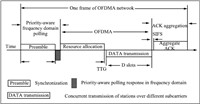 | Download: |
| Fig. 3 Architecture of PFDP-MAC protocol. | |
We assume that the priorities of stations are classified into multiple levels. In PFDP-MAC,station $k(k = 1,2,\ldots ,K)$ is assigned $T_{k}$ different subcarriers,i.e.,${s_{k,1}},{s_{k,2}},\ldots ,{s_{k,{T_k}}}$. We use subcarriers to identify transmission priorities of stations. Without loss of generality,we label priorities of station $k,i.e.,\{ {A_{k,i}}\} $,in an increasing manner,namely,$1 = {A_{k,1}} \le {A_{k,2}} \le \cdots \le {A_{k,{T_k}}} = {T_k}.{A_{k,i}}$ corresponds to the case when the remaining lifetime of the packet at station k lies in the time interval $[{t_{{\rm{k}},i{\rm{ + 1}}}},{t_{k,i}})$,where ${t_{k,i}} \in {{\bf{R}}^ + },{t_{k,i}} > {t_{k,i + 1}},i = 1,2,\ldots ,{T_k}$,and $t_{k,T_{k}+1}=0$. For stations whose packets are not delivered successfully in the current frame,their priorities will be increased by $1$ in the coming frame.
With the above preparation in hand,we are now ready to illustrate the priority-aware frequency domain polling method. We introduce a bijective mapping: $\forall k,f({A_{k,i}}) = {s_{k,i}},i = 1,2,\ldots ,{T_k}$. Then station k could notify the AP that it has a packet with priority $i$ to send by simply transmitting one symbol on subcarrier ${s_{k,i}}$. For simplicity,we let ${T_k} = T,k = 1,2,\ldots ,K$.
Fig. 4 shows an example of priority-aware frequency domain polling,in which each station is assigned four subcarriers (i.e.,T=4) and each subcarrier represents one priority. In this example,A (subcarriers {1,2,3,4}),B (subcarriers {5,6,7,8}),and C (subcarriers {17,18,19,20}) have packets to transmit. The AP starts the priority-aware polling with a preamble. After synchronizing with the AP in preamble phase,each station with pending packet immediately selects one allocated subcarrier (which depends on its priority) and sends one symbol over it. In Fig. 4,subcarriers 4,8 and 19 are detected active via energy detection,and the AP then knows that stations A,B and C would like to transmit packets with priorities 4,4 and 3,respectively. Notice that,these symbol transmissions occur simultaneously in the time domain.
 | Download: |
| Fig. 4 Priority-aware frequency domain polling. | |
${\bf Remark 1.}$ In the example of Fig. 4,for easy illustration,we simply allocate a block of four adjacent subcarriers to each station. However,the ways of identifying stations and priorities with subcarriers are diverse. The comparison between different identifying ways in terms of polling accuracy is out of the scope of this paper.
${\bf Remark 2.}$ If there are multiple selfish (or malicious) stations,which always claim the highest priority,the reliability performance of the proposed scheme will definitely degrade. At the moment,the proposed MAC cannot mitigate the harmful influence of selfish (or malicious) stations. However,we believe that the combination of a reputation updating mechanism[30] and this work may help us target the selfish (or malicious) stations. Future work will focus on the design of PFDP-MAC which is robust against selfish (or malicious) stations.
B. Architecture Comparison
In order to highlight the contributions of this paper,this subsection retrospects the architecture of FDP-MAC in [25]. FDP-MAC[25] consists of three phases as showed in Fig. 5. In the first phase of FDP-MAC,a frequency domain polling process is performed to achieve simultaneous polling of multiple stations. A dynamic TDMA scheduling is carried out to allocate time slots according to the actual demand of each station in the second phase. At last a downlink acknowledgements aggregation is proposed to reduce the overhead of wireless physical layer.
 | Download: |
| Fig. 5 Architecture of FDP-MAC protocol[25]. | |
As FDP-MAC[25] identifies each station with a unique subcarrier ID,the priority information of each station cannot be attained through frequency domain polling. In [25],one OFDM system (compliant with the IEEE 802.11a/g[31]) containing 48 data subcarriers is adopted for frequency domain polling,which means that FDP-MAC can at most poll $48$ stations at a time. This is already a huge improvement compared with the polling-based IEEE 802.11 MAC. However,as this work adopts an OFDMA system whose subcarriers quantity is the multiple of 1 024 (i.e.,$S = 1024m,m \in {{\bf{Z}}^ + }$),the polling efficiency (the number of stations polled at a time) of PFDP-MAC is higher than that of FDP-MAC when $T < 21m(S > 21m \times 48)$. For both FDP-MAC and PFDP-MAC,we have to exploit multiple frames to accomplish one complete polling and transmission scheduling of stations when the number of served stations is larger than the polling efficiency of the employed MAC protocol.
The OFDMA phase in PFDM-MAC allows the concurrent transmission of multiple loaded stations,which saves considerable time in comparison to the dynamic TDMA phase in FDM-MAC when the number of loaded stations are numerous.
IV. OFDMA RESOURCE ALLOCATION
In many factory automation applications,packets missing deadlines (termed as outdated packets) are of limited use for industrial system and usually discarded by stations[32]. Consequently,low packet delivery ratio may lead the automation process to suffer destructive influences,e.g.,an outage of the production line,a damage of the factory machine and even the loss of workers' lives. Different from traditional OFDMA networks desiring high throughput,the OFDMA resource allocation of PFDP-MAC protocol in this paper aims to reduce the number of outdated packets.
A. Problem Formulation
After the priority-aware polling phase of PFDP-MAC,all the subcarriers can be used for communication. Let $S = \{ 1,2,\ldots ,S\} $ denote the set of available subcarriers.
Without loss of generality,multiple quadrature amplitude modulation (M-QAM) is adopted by the physical layer of the OFDMA network. Given a signal-to-noise ratio (SNR) $\gamma$ and modulation factor M (the number of points of the QAM constellation),the bit error rate (BER) of M-QAM is given as follows[33]:
| \[P(M) = \frac{4}{{{{\log }_2}M}}\left( {1 - \frac{1}{{\sqrt M }}} \right)Q\left( {\sqrt {\frac{{3\gamma }}{{M - 1}}} } \right),\] | (1) |
Similarly,the BER of station k if communicating over subcarrier $s \in S$ with ${M_{k,s}}$-QAM is given by
| \[P_{k,s}^{ber} = \frac{4}{{{{\log }_2}{M_{k,s}}}}\left( {1 - \frac{1}{{\sqrt {{M_{k,s}}} }}} \right)Q\left( {\sqrt {\frac{{3{\gamma _{k,s}}}}{{{M_{k,s}} - 1}}} } \right),\] | (2) |
Let L denote the packet size and then the packet error rate (PER) of station k is calculated as:
| \[{e_{k,s}} = 1 - {\left( {1 - P_{k,s}^{ber}} \right)^L}.\] | (3) |
| \[\Pr (k) = {\beta _{{P_k}}}\prod\limits_{s = 1}^S {\prod\limits_{t = 1}^D {{{\left( {{e_{k,s}}(t)} \right)}^{{\delta _{k,s}}(t)}}} } ,\] | (4) |
Consequently,the OFDMA resource allocation problem aiming to minimize the overall outdated packets is formulated as follows:
| \[{\mathop {\min }\limits_{{\delta _{k,s}}(t),{p_{k,s}}(t),{M_{k,s}}(t)} \sum\limits_{k = 1}^K {\Pr } (k),}\] | (5a) |
| \[{{\rm{s}}.{\rm{t}}.\;\sum\limits_{k = 1}^K {{\delta _{k,s}}} (t) \le 1,\;\forall s,t,}\] | (5b) |
| \[{\qquad \sum\limits_{s = 1}^S {{p_{k,s}}} (t) \le {p_{\max }},\;\forall k,t,}\] | (5c) |
| \[{\qquad {\delta _{k,s}}(t) \in \{ 0,1\} ,\;\forall k,s,t,}\] | (5d) |
| \[{\qquad {p_{k,s}}(t) \ge 0,\;\forall k,s,t,}\] | (5e) |
| \[{\qquad {M_{k,s}}(t) \in F = \{ 4,8,16,32,64\} ,\;\forall k,s,t.}\] | (5f) |
Constraint (5b) limits each subcarrier to be assigned to at most one station in one time slot. Constraint (5c) requires the total transmission power of each station to be upper bounded by ${p_{\max }}$,where ${p_{\max }}$ is specified according to some hardware or regulatory limitations. Constraints (5d)-(5f) are simple physical constraints.
Since problem (5) is NP-complete due to the discrete nature of subcarrier allocation,the complexity of finding the optimal solution is extremely high[34]. Section \ref{subsec:heuristicsolution} will devote to the derivation of a heuristic solution with low computational complexity to problem (5).
B. Heuristic Solution
The objective function of problem (5) is so complex that existing works on OFDMA resource allocation[34] do not apply to this work. For this,Section IV-B first proposes two important heuristic rules,which then facilitate us to design a heuristic algorithm to solve the problem (5).
For reliably transmitting one packet with M-QAM modulation,we could either transmit the modulated symbols one time with a small modulation factor M (W1) or many times with a big M (W2) ahead of the specified deadline. In the following,we will show that W1 yields a higher transmission reliability than W2. For any ${M_{{i_1}}}$ and ${M_{{i_2}}},{M_{{i_1}}},{M_{{i_2}}} \in F$ and ${M_{{i_1}}} < {M_{{i_2}}}$,the BER of ${M_j} - QAM(j \in \{ {i_1},{i_2}\} )$ modulation is given by
| \[P({M_j}) = \frac{4}{{{{\log }_2}{M_j}}}\left( {1 - \frac{1}{{\sqrt {{M_j}} }}} \right)Q\left( {\sqrt {\frac{{3\gamma }}{{{M_j} - 1}}} } \right).\] | (6) |
| \[e({M_j}) = {\left( {1 - {{\left( {1 - P({M_j})} \right)}^L}} \right)^{\frac{{{M_j}}}{{{M_{{i_1}}}}}}},{\rm{ }}j \in \{ {i_1},{i_2}\} .\] | (7) |
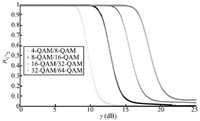 | Download: |
| Fig. 6 $q_{i_{1},i_{2}}$ for different M-QAM schemes (L=160 bits). | |
${\bf Heuristic 1.}$ Low rate M-QAM modulation schemes are adopted for high reliability when time slots are sufficient.
When multiple subcarriers are available for transmission,stations could send packets over one subcarrier with maximal power ($\widehat W$1) or distribute the transmission over multiple subcarriers by power allocation ($\widehat W$2). Suppose that cases $\widehat W$1 and $\widehat W$2 exploit the same M-QAM modulation scheme and $S_{h}$ subcarriers are with equal bandwidth and noise power. Similar to (6) and (7),the PER of M-QAM in case $\widehat W$1 is given by
| \[\hat e = 1 - {\left( {1 - P(M)} \right)^L}.\] | (8) |
| \[\hat e(\omega ) = \prod\limits_{i = 1}^{{S_h}} {\left( {1 - {{\left( {1 - P({\omega _i})} \right)}^L}} \right)} ,\] | (9) |
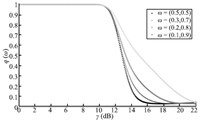 | Download: |
| Fig. 7 $q(\omega)$ for different weights (${S_h} = 2$,8-QAM). | |
${\bf Heuristic 2.}$ For reliable transmission,each scheduled station in any time slot communicates over only one subcarrier with the maximum transmit power.
At the beginning of the OFDMA phase,the AP updates the priority coefficients in the OFDMA resource allocation problem in current frame. Let $\mu_{i}(n)$ and $\hat{\mu}_{i}(n)$ denote the number of totally transmitted and successfully transmitted packets with priority $i$ in the $n$th frame,respectively. Using the exponential moving average technique,we update the estimated number of totally transmitted and successfully transmitted packets with priority $i$ (i.e.,$\mu_{i}^{h}(n)$ and $\hat{\mu}_{i}^{h}(n)$) as follows:
| \[{\mu _i^h(n) = (1 - \theta )\mu _i^h(n - 1) + \theta {\mu _i}(n),}\] | (10a) |
| \[{\hat \mu _i^h(n) = (1 - \theta )\hat \mu _i^h(n - 1) + \theta {{\hat \mu }_i}(n),}\] | (10b) |
${\bf Algorithm 1.~TPMA algorithm}$
${\bf{Input}}.\;\forall k,s:{h_{k,s}},{p_{\max }},{\beta _{{P_k}}},{M_{\min }},{M_{\max }},D,K,S,{\bf{D}} = \{ 1,$
$\quad 2,\ldots ,D\} ,K = \{ 1,2,\ldots ,K\} .$
1. Initialization: $\forall k,s,t,{\alpha _k} = {\beta _{{P_k}}},{\delta _{k,s}}(t) = 0,$
$\quad {p_{k,s}}(t) = 0,{M_{k,s}}(t) = 0 .$
2. ${\bf for\;all}$ time slot $t \in {\bf{D}}\;{\bf{do}}$
3. $\quad$ Initialization of the subcarriers set and the stations set for
$\qquad$ each time slot: ${\pmb S} = \{ 1,2,\ldots ,S\} $ and ${\pmb K} = \{ 1,2,\ldots ,K\} .$
4. $\quad {\bf repeat }$
5. $\qquad$ from station set with the largest time output probability,
$\qquad \quad i.e.,{k^*} \in \arg {\max _{k \in {\pmb K}}}{\alpha _k}$,randomly select one station $k^{*}$.
6. $\qquad$ from subcarrier set with the highest channel gain,i.e.,$s^{*}$
$\qquad \quad \in \arg {\max _{s \in {\pmb S}}}{h_{{k^*},s}}$,randomly select one channel $s^{*}$ for
$\qquad\quad$ station $k^{*}$.
7. $\qquad$ assign subcarrier $s^{*}$ to station $k^{*}$,i.e.,$\delta_{k^{*},s^{*}}(t)=1$,and
$\qquad\quad$ remove station $k^{*}$ and subcarrier $s^{*}$ from ${\pmb K}$ and ${\pmb S}$,resp-
$\qquad\quad$ ectively,i.e.,${\pmb K} = {\pmb K}\backslash \{ {k^*}\} $ and ${\pmb S} = {\pmb S}\backslash \{ {s^*}\} $.
8. $\qquad$ station $k^{*}$ allocates all its power to the subcarrier $s^{*}$,i.e.,
| \[{p_{k,s}}(t) = \left\{ {\begin{array}{*{20}{l}} {{p_{\max }},}&{{\rm{if}}\;k = {k^*},s = {s^*},}\\ {0,}&{{\rm{otherwise}}.} \end{array}} \right.\] |
9. $\qquad {\bf if}$ subcarrier $s^{*}$ is not allocated to station
$k^{*}$ in slot t-1,
$\qquad\quad$ i.e,${\delta _{{k^*},{s^*}}}(t - 1) = 0\;{\bf{then}}$
10. $\qquad \quad$ station $k^{*}$ selects $M_{\max}$-QAM for transmission in slot
$\qquad \qquad t$,i.e.,$M_{k,s}(t)=M_{\max}$,and set $\alpha_{k}=\alpha_{k}e(M_{\max})$,
$\qquad\qquad$ where $e(\cdot)$ is defined in (7).
11. $\qquad {\bf else}$
12. $\qquad \quad$ station $k^{*}$ selects $M_{\min}$-QAM for transmission in slot
$\qquad \qquad t$,i.e.,${M_{k,s}}(t) = {M_{\min }}$,and set ${\alpha _k} = {\alpha _k}\frac{{e({M_{\min }})}}{{e({M_{\max }})}}$.
13. $\qquad {\bf end if}$
14. $\qquad {\bf{until}}\;{\pmb K} = \emptyset\;or\;{\pmb S} = \emptyset $
15. ${\bf end for}$
${\bf Output.}$ optimized configuration: $\{ {\delta _{k,s}}(t),{p_{k,s}}(t),{M_{k,s}}(t)\} $.
The complexity of Algorithm 1 is determined by the double nested loop (Steps 2-15). The stopping condition for Algorithm 1 can be achieved in D outer loops,and each inner loop (whose complexity is determined by Steps 5 and 6,each with complexity $\mathrm{O}(K)$ and $\mathrm{O}(S)$,respectively),terminates when ${\pmb K} = \emptyset$ or ${\pmb S}=\emptyset$ is reached. In turn,the complexity of the whole heuristic is $\mathrm{O}(D\Delta^{2})$,where $\Delta=\max\{K,S\}$.
${\bf Remark 3.}$ In PFDP-MAC,the priority-aware frequency domain polling is prone to the background noise and external interference. The negative effect of the imperfect polling could be alleviated either by allocating more subcarriers to stations or incorporating the probability of polling errors into the formulation of the OFDMA resource allocation. We will leave the design of an improved PFDM-MAC,which is robust to the imperfectness in polling,as a future work.
V. SIMULATION
In this section,simulations are employed to evaluate the performance of PFDP-MAC. We compare PFDP-MAC (TPMA) with unsolicited grant service (UGS) and real-time polling service (rtPS) of IEEE 802.16[29]. The critical performance metrics\footnote{The traffic in CPS networks (typical machine to machine communication) mainly consists of periodic small packets including plant state or control sequence with fixed size. Therefore,throughput is not a suitable performance metric for CPS networks.} of CPS networks are considered as follows: 1) Percentage of outdated packets: it is defined as the ratio of outdated packets to the packets sent by senders. The lower the value of this parameter,the higher the data reliability. 2) Average delay: it is defined as the average delay of the successfully delivered packets. The lower the delay,the better the real-time performance.
Considering the traffic characteristic of industrial CPS applications,we assume a cyclic traffic with period $T_{\rm period}$ for each station,which implies that all stations are saturated in each simulated frame. However,due to synchronization issues,jitters may happen during the packet generating process and for this we assume the packet generating time is uniformly distributed in the time interval $[T_{\rm period}-T_{\rm jitter},T_{\rm period}+T_{\rm jitter}]$,where $T_{\rm jitter}$ represents the largest duration of traffic jitters. The simulation parameters are selected in compliance with the IEEE 802.16[16] (see Table I for details). For fair comparison,we only consider the uplink communication. We have conducted our simulations on a Lenovo Thinkstation with a 3.4 GHz CPU and 16 GB RAM. The simulation platform is programmed by C++.
| Table I PARAMETER VALUES USED IN THE SIMULATION |
Figs. 8 and 9 depict the comparison results between TPMA and two services of IEEE 802.16 (UGS and rtPS) from different perspectives. IEEE 802.16 defines UGS to support real-time service flows that generate fixed size data packets periodically and defines rtPS to support variable bit-rate flows that have specific bandwidth requirements as well as the maximum latency.
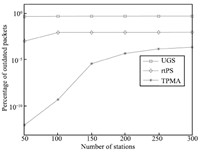 | Download: |
| Fig. 8 Percentage of outdated packets versus number of stations. | |
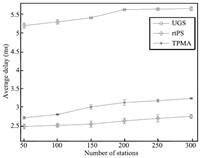 | Download: |
| Fig. 9 Average delay versus number of stations. | |
Fig. 8 shows that the reliability performance (percentage of outdated packets) is ranked as UGS < rtPS < TPMA,no matter how many stations are involved in the simulation. Different from UGS and rtPS,the reliability of TPMA decreases as the number of stations increases. However,we notice that TPMA could still guarantee the percentage of outdated packets as low as 2.33×10-6 when K=300. We can also observe that the reliability of TPMA when K=100 meets the reliability requirement of typical industrial automation applications (e.g.,10-9 for 100 nodes per roundtable production cell and $40$ nodes per robot manufacturing cell)[25].
Fig. 9 shows that the average delay is ranked as UGS < TPMA < rtPS,where whiskers denote the 95 % confidence interval. As rtPS is designed specifically to improve the real-time performance,rtPS presents the best delay performance among all compared schemes. However,the poor reliability performance of rtPS prohibits its use in CPS networks. In contrast,TPMA presents a high reliability performance while preserving a rather low average delay (2.7-3.3 ms) which is quite close to the average delay of rtPS.
Fig. 10 depicts the comparison results between TPMA,UGS and rtPS in terms of running time. It is clearly shown that the running time is ranked as rtPS < UGS < TPMA. Specifically,the running time of TPMA grows with the number of nodes,which verifies the scalability and the complexity analysis of Algorithm 1. Combining Figs. 8-10,we can conclude that the proposed PFDP-MAC with the TPMA algorithm is a good candidate MAC for CPS networks.
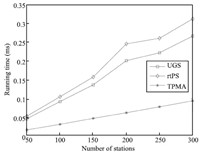 | Download: |
| Fig. 10 Running time versus number of stations. | |
Finally,we carry out the performance evaluation of real-time under different SNRs (${\gamma _{k,s}}$ varies from -10 dB to 10 dB) and find similar comparison results as Figs. 8-10. Therefore,in this paper we omit the comparison results under different ${\gamma _{k,s}}$s for concise presentation.
VI. CONCLUSION AND FUTURE WORK
Wireless technology is a promising solution to CPS networking. However,due to the low efficiency of conventional MAC protocols,existing wireless technologies cannot meet the rigorous performance requirement of typical CPS applications,such as factory automation. To this end,this paper proposed a PFDP-MAC protocol for OFDMA-based CPS networks. By using physical layer signaling techniques of OFDMA networks for polling,PFDP-MAC could poll multiple stations and collect their priorities concurrently. Besides,we optimized the resource allocation in the OFDMA network for reliable communication. Extensive simulations validated the efficiency of PFDP-MAC under different scenarios. This paper presented a PFDP-MAC protocol for the industrial OFDMA network for factory automation. By using OFDM subcarrier modulation,PFDP-MAC could poll multiple stations and collect their priorities concurrently in the time domain. In addition,we optimized the resource allocation in the OFDMA network for reliable communication. In order to address the NP-completeness of the OFDMA resource allocation problem,we proposed a lightweight heuristic algorithm (termed TPMA) to solve the OFDMA resource allocation,based on two heuristic rules. Extensive simulations showed that the reliability requirements of typical CPS applications could be met by PFDP-MAC. The performance gain of PFDP-MAC over IEEE 802.16 MAC was demonstrated under different scenarios as well.
Apart from the future works in Remark 2 and Remark 3,we will also implement the proposed PFDP-MAC on real CPS network platforms in the near future.
| [1] | Poovendran R. Cyber-physical systems: close encounters between two parallel worlds. Proceeding of the IEEE, 2010, 98(8): 1363-1366 |
| [2] | Sztipanovits J, Koutsoukos X, Karsai G, Kottenstette N, Antsaklis P, Gupta V, Goodwine B, Baras J, Wang S. Toward a science of cyberphysical system integration. Proceeding of the IEEE, 2012, 100(1): 29-44 |
| [3] | Kim K D, Kumar P R. Cyber-physical systems: a perspective at the centennial. Proceeding of the IEEE, 2012, 100: 1287-1308 |
| [4] | Vicaire P A, Hoque E, Xie Z H, Stankovic J A. Bundle: a group-based programming abstraction for cyber-physical systems. IEEE Transactions on Industrial Informatics, 2012, 8(2): 379-392 |
| [5] | Kang W, Kapitanova K, Son S H. RDDS: a real-time data distribution service for cyber-physical systems. IEEE Transactions on Industrial Informatics, 2012, 8(2): 393-405 |
| [6] | Bonakdarpour B. Challenges in transformation of existing real-time embedded systems to cyber-physical systems. ACM SIGBED Review, 2008, 5(1): 1-2 |
| [7] | Fisher A, Jacobson C A, Lee E A, Murray R M, Sangiovanni-Vincentelli A, Scholte E. Industrial cyber-physical systems — iCyPhy. Complex Systems Design and Management. Switzerland: Springer International Publishing, 2014. 21-37 |
| [8] | Lin C Y, Zeadally S, Chen T S, Chang C Y. Enabling cyber-physical systems with wireless sensor networking technologies. International Journal of Distributed Sensor Networks, 2012, 2012: Article ID 489794, doi: 10.1155/2012/489794 |
| [9] | Cao X H, Cheng P, Chen J M, Sun Y X. An online optimization approach for control and communication codesign in networked cyberphysical systems. IEEE Transactions on Industrial Informatics, 2013, 9(1): 439-450 |
| [10] | Cao X H, Cheng P, Chen J M, Ge S S, Cheng Y, Sun Y. Cognitive radio based state estimation in cyber-physical systems. IEEE Journal on Selected Areas in Communications, 2014, 32(3): 489-502 |
| [11] | Chen J, Yu Q, Chai B, Sun Y, Fan Y, Shen X X. Dynamic channel assignment for wireless sensor networks: a regret matching based approach. IEEE Transactions on Parallel and Distributed Systems, 2015, 26(1): 95-106 |
| [12] | Misra S, Krishna P V, Sritha V, Agarwal H, Shu L, Obaidat M S. Efficient medium access control for cyber-physical systems with heterogeneous networks. IEEE System Journal, 2013, 9(1): 22-30 |
| [13] | Willig A. Recent and emerging topics in wireless industrial communications: a selection. IEEE Transactions on Industrial Informatics, 2008, 4(2): 102-124 |
| [14] | Wu F J, Kao Y F, Tseng Y C. From wireless sensor networks towards cyber physical systems. Pervasive and Mobile Computing, 2011, 7(4): 397-413 |
| [15] | Zheng M, Liang W, Yu H B. An optimization framework for optimal replicator factors control in wireless sensor networks. Adhoc and Sensor Wireless Networks, 2011, 13(3-4): 271-289 |
| [16] | Gamba G, Tramarin F, Willig A. Retransmission strategies for cyclic polling over wireless channels in the presence of interference. IEEE Transactions on Industrial Informatics, 2010, 6(3): 405-415 |
| [17] | Zhang X L, Liang W, Yu H B, Feng X S. Reliable transmission scheduling for multi-channel wireless sensor networks with low-cost channel estimation. IET Communications, 2013, 7(1): 71-81 |
| [18] | Willig A, Uhlemann E. Deadline-aware scheduling of cooperative relayers in TDMA-based wireless industrial networks. Wireless Networks, 2014, 20(1): 73-88 |
| [19] | Willig A. Polling-based MAC protocols for improving real-time performance in a wireless PROFIBUS. IEEE Transactions on Industrial Electronics, 2003, 50(4): 806-817 |
| [20] | Seno L, Vitturi S, Zunino C. Analysis of ethernet powerlink wireless extensions based on the IEEE 802.11 WLAN. IEEE Transactions on Industrial Informatics, 2009, 5(2): 86-98 |
| [21] | Gamba G, Seno L, Vitturi S. Theoretical and experimental evaluation of polling times for wireless industrial networks using commercially available components. In: Proceedings of the 2010 IEEE Conference on Emerging Technologies and Factory Automation. Bilbao: IEEE, 2010. 1-8 |
| [22] | Son J B, Choi H, Park S C. An effective polling MAC scheme for IEEE 802.11e. In: Proceedings of the 2004 IEEE International Symposium on Communications and Information Technology. Sapporo, Japan: IEEE, 2004. 296-301 |
| [23] | Perez D, Valenzuela J L, Villares J. Multipolling and OFDMA reservation protocol for IEEE 802.11 networks. In: Proceedings of the 6th International Symposium on Wireless Communication Systems. Tuscany: IEEE, 2009. 191-195 |
| [24] | Lam R Y W, Leung V C M, Chan H C B. Polling-based protocols for packet voice transport over IEEE 802.11 wireless local area networks. IEEE Wireless Communications, 2006, 13(1): 22-29 |
| [25] | Xiao Y, Lin J, Liang W, Yu H B. Polling in the frequency domain: a new MAC protocol for industrial wireless network for factory automation. International Journal of Ad Hoc and Ubiquitous Computing, 2014 accepted[Online], available: http://www.inderscience.com/info/ingeneral/forthcoming.php?jcode=ijahuc, September 4, 2015 |
| [26] | Sen S, Choudhury R R, Nelakuditi S. No time to countdown: migrating backoff to the frequency domain. In: Proceedings of the 17th ACM MobiCom. New York, USA: ACM, 2011. 241-252 |
| [27] | Feng X J, Zhang J, Zhang Q, Li B. Use your frequency wisely: explore frequency domain for channel contention and ACK. In: Proceedings of the 2102 IEEE INFOCOM. Orlando, FL: IEEE, 2012. 549-557 |
| [28] | Wang L, Wu K S, Xiao J, Hamdi M. Harnessing frequency domain for cooperative sensing and multi-channel contention in CRAHNs. IEEE Transactions on Wireless Communication, 2014, 13(1): 440-449 |
| [29] | IEEE 802.16-2004, “IEEE Standard for Local and Metropolitan Area Networks, Air Interface for Fixed Broadband Wireless Access Systems”, 2004. |
| [30] | Zeng K, Pawełczak P, čabrić D. Reputation-based cooperative spectrum sensing with trusted nodes assistance. IEEE Communications Letters, 2010, 14(3): 226-228 |
| [31] | IEEE 802.11, “Wireless LAN Medium Access Control (MAC) and Physical (PHY) Layer Specifications”, 1999. |
| [32] | Yu K, Pang Z B, Gidlund M, Å keberg J, Bjőrkman M. REALFLOW: reliable real-time flooding-based routing protocol for industrial wireless sensor networks. International Journal of Distributed Sensor Networks, 2014, 2014, Article ID 936379, doi: http://dx.doi.org/10.1155/2014/936379 |
| [33] | Rappaport T S. Wireless Communications: Principles and Practice (2nd edition). New Jeesey: Prentice Hall, 2002. |
| [34] | Yaacoub E, Dawy Z. A survey on uplink resource allocation in OFDMA wireless networks. IEEE Communications Surveys and Tutorials, 2012, 14(2): 322-337 |
 2015, Vol.2
2015, Vol.2 


